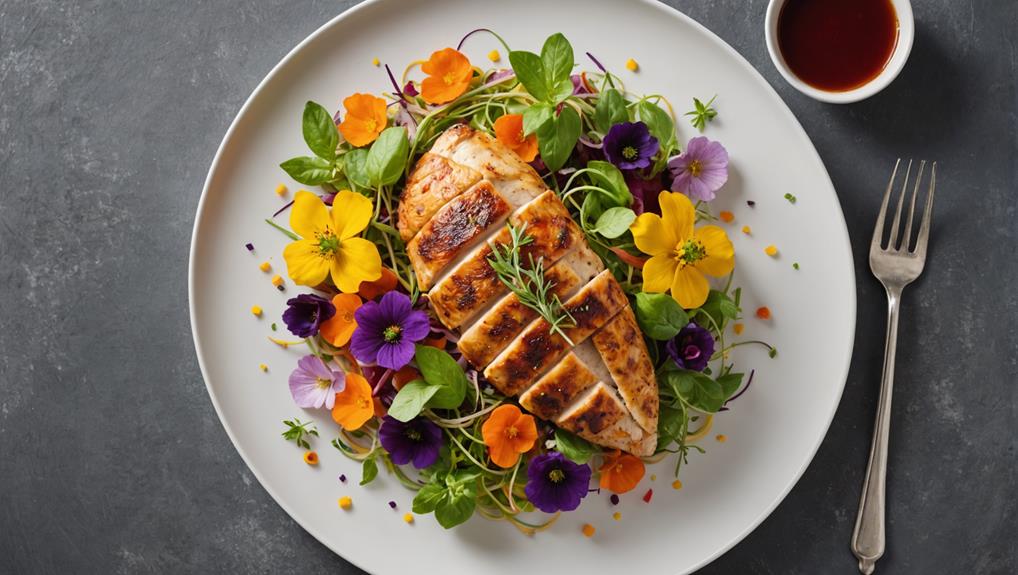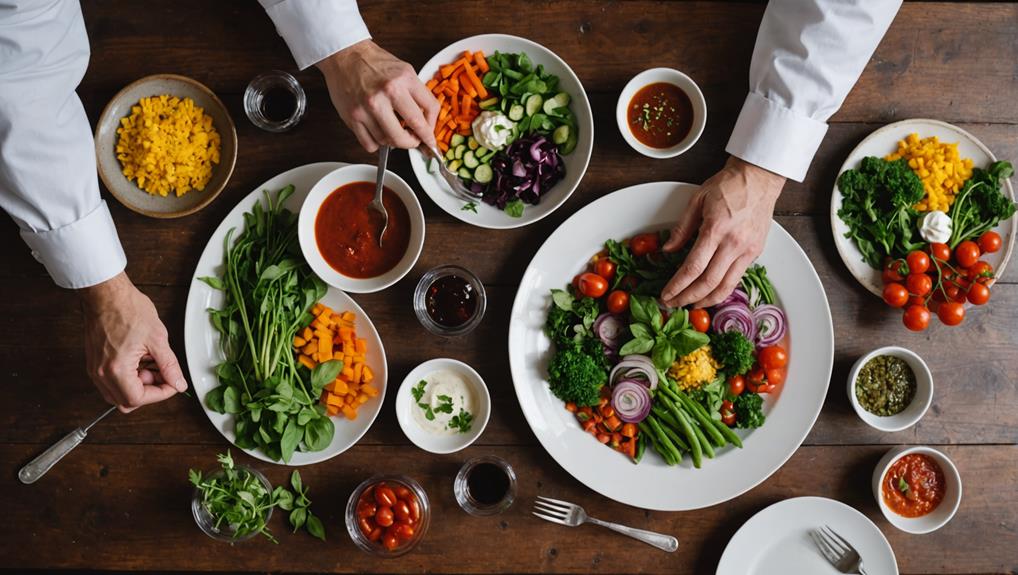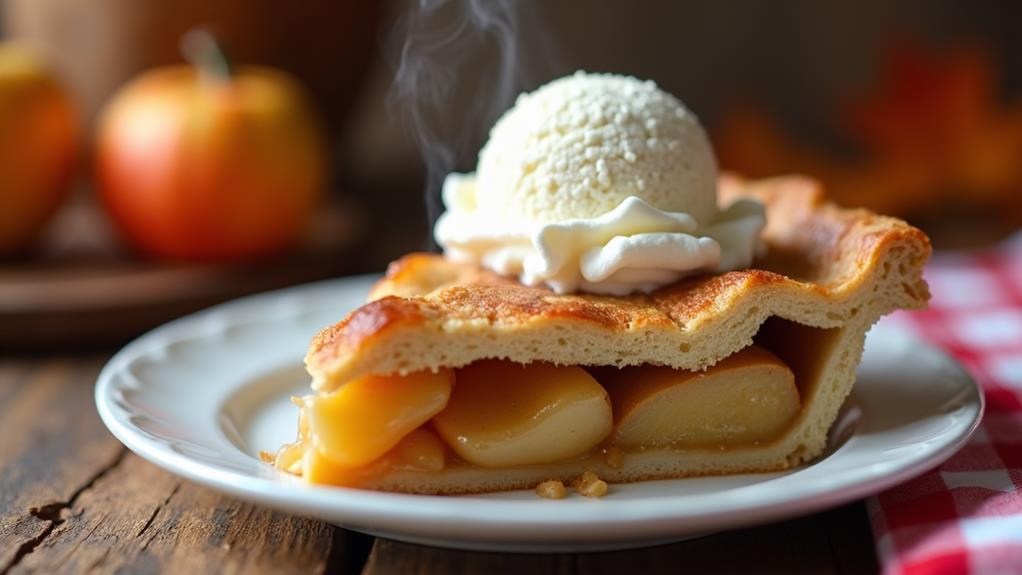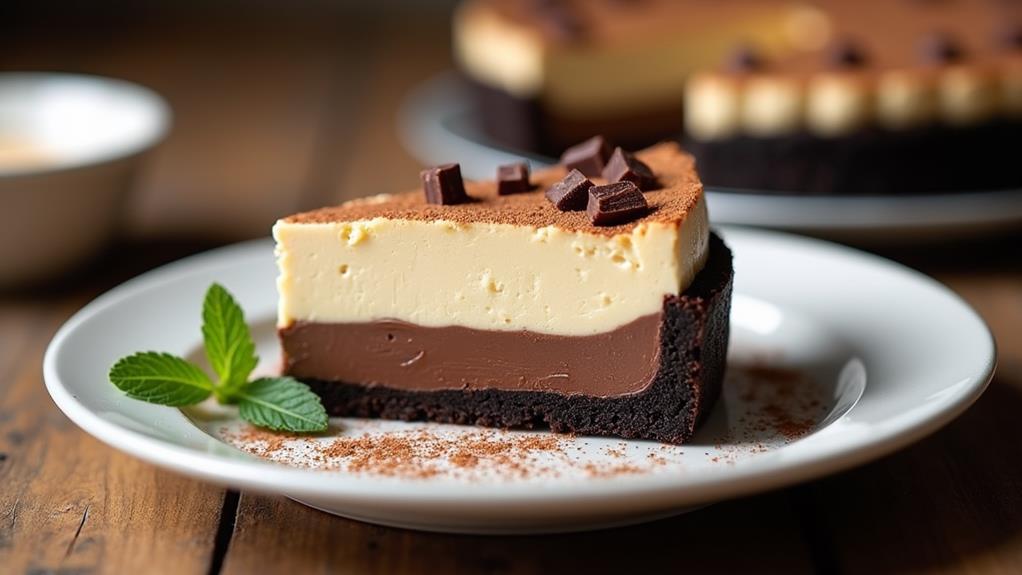Transform your everyday meals into culinary masterpieces with simple plating techniques. Start by mastering color harmony, using complementary or analogous palettes to enhance visual appeal. Follow the classic plating method, positioning carbs at 11:00, veggies at 2:00, and protein at 6:00 for balanced proportions. Add thoughtful garnishes in odd numbers to elevate both flavor and aesthetics. Experiment with artistic layouts, incorporating abstract designs or nature-inspired elements. Play with textures and height to create depth and intrigue on the plate. By combining these techniques, you'll turn ordinary dishes into extraordinary dining experiences. Discover how these secrets can revolutionize your home cooking.
The Art of Color Harmony
When it comes to culinary plating, mastering the art of color harmony can transform an ordinary dish into a visual masterpiece. The harmonious blend of colors in dishes like a watermelon feta salad can serve as a delightful inspiration for your own presentations.
By understanding color theory, you'll be plating like a pro in no time. Start by experimenting with different color combinations to create striking contrasts or harmonious blends. Complementary colors, such as blue and orange, can make your dish pop, while an analogous color palette using colors that sit next to each other on the color wheel can create a more cohesive look.
Don't underestimate the power of even monochromatic colors. Subtle variations in tone of a single color can produce a calming, elegant look that's perfect for sophisticated presentations.
Try using shades ranging from light pink to deep burgundy for a beautiful dish that arrives at the table with undeniable style.
Mastering Portion Proportions
Beyond the visual appeal of colors, mastering portion proportions is key to creating a well-balanced plate. By adhering to the classic plating technique, you'll revolutionize your culinary presentation. Position carbohydrates at 11:00, vegetables at 2:00, and protein at 6:00 to achieve visual harmony that's both aesthetically pleasing and nutritionally sound.
For the protein portion, aim for a size roughly equivalent to your palm. This ensures it's the focal point while providing adequate nutrition.
Vegetables should occupy half the plate, showcasing a variety of colors and textures to enhance visual appeal and nutritional value. Carbohydrates, typically the size of your fist, complete the trio as a satisfying yet proportionate accompaniment.
To master these essential techniques, consider using a scale or measuring tools during initial practice. This helps you understand and consistently replicate proper portion sizes.
As you hone your skills, you'll effortlessly create plates that not only look stunning but also promote a balanced diet. By mastering portion proportions, you're not just plating food; you're crafting a visual and nutritional masterpiece that elevates your daily dishes to new heights.
Garnishing With Flair

With an eye toward elevating your culinary creations, garnishing with flair can transform an ordinary plate into a work of art. By thoughtfully selecting garnishes that complement your dish's flavors and textures, you'll enhance its visual appeal and create a more engaging dining experience.
For instance, consider adding fresh basil leaves or drizzling balsamic glaze for a touch of elegance, as seen in Caprese Salad Skewers. These elements not only enhance aesthetics but also enrich flavor profiles. Think about using edible flowers, citrus zest, or fresh herbs to add pops of color and harmonize with your main ingredients.
To truly master the art of garnishing, remember these key principles:
- Use odd numbers of garnish elements for visual interest
- Choose high-quality oils as both flavor enhancers and decorative accents
- Select garnishes that complement, not overpower, the dish's flavors
- Think of your plate as a canvas for culinary art
- Aim for balance between simplicity and sophistication
When garnishing, think beyond mere decoration. A well-placed sprig of herbs or a drizzle of flavored oil can elevate your dish's taste profile while adding visual intrigue.
Experiment with different textures, such as crispy fried herbs or velvety sauces, to create contrast and depth. By mastering these techniques, you'll transform simple meals into memorable culinary experiences that delight both the eye and the palate.
Creating Artistic Layouts
Creating Artistic Layouts
After mastering the art of garnishing, it's time to focus on creating artistic layouts that transform your plate into a canvas. Embrace culinary wizardry by exploring various plate design techniques that elevate your dishes from ordinary to extraordinary. For example, consider the vibrant colors and textures found in Sweet Potato and Black Bean Tacos—the bright hues of roasted sweet potatoes and fresh toppings can inspire stunning presentations.
Start with the classic plating method, positioning carbohydrates at 11:00, vegetables at 2:00, and protein at 6:00 to achieve visual harmony. This approach ensures balanced proportions and creates an inviting presentation.
For a more innovative touch, experiment with abstract plating. Incorporate diverse shapes, textures, and negative space to craft a visually striking arrangement that resembles a work of art. Draw inspiration from nature by using flowing lines and artistic sauce drizzles to mimic landscapes and enhance movement on the plate.
Don't be afraid to break the rules with asymmetry and odd numbers in your layouts. These techniques can evoke a sense of abundance and excitement in your dish presentation.
To perfect your artistic layouts, try sketching designs beforehand. This practice helps you visualize ingredient placement and ensures a more organized, aesthetically pleasing final presentation. With these plating secrets, you'll unlock new levels of culinary creativity and impress your guests with every dish.
Playing With Textures and Height

Three key elements transform a dish from ordinary to extraordinary: flavor, texture, and visual appeal. When playing with textures and height, you're not just cooking; you're creating edible art.
By incorporating creamy sauces, crunchy toppings, and tender proteins, you'll craft a dynamic mouthfeel that elevates the entire dining experience.
To add visual drama, build height in your plating. Stack ingredients or use garnishes like microgreens to draw the eye upward. Layering different textures, such as a smooth puree base topped with crispy vegetables, not only adds interest but enhances flavor perception.
For a striking focal point, try creating freestanding towers with grilled vegetables or proteins.
Embrace asymmetrical arrangements to evoke a sense of abundance and excitement. This approach transforms simple dishes into artistic experiences.
Consider these emotions when plating:
- Anticipation: Heightened expectations from visual appeal
- Curiosity: Intrigue sparked by unique textures
- Delight: Pleasure from discovering contrasting elements
- Satisfaction: Fulfillment from a well-balanced composition
- Inspiration: Motivation to experiment with your own creations
Frequently Asked Questions
How Do You Elevate Simple Dishes?
Elevate your dishes by mastering color contrasts, texture balance, and height variation. Use strategic garnish placement and sauce techniques. Choose appropriate plates, control portions, maintain theme consistency, and incorporate seasonal ingredients. Create visual stories that captivate and inspire innovation.
What Are the 5 Basic Elements of Plating?
You're about to discover the culinary secrets that transform ordinary meals into works of art. Ready? The five basic elements of plating are: color contrasts, texture variety, composition with height variation, strategic garnish placement, and thoughtful sauce application. Elevate your dishes now!
How to Plate up Food Like a Chef?
You'll plate like a pro by mastering garnish techniques, creating color contrast, and selecting the right plate. Vary height, apply sauces artfully, balance textures, control portions, and use edible flowers. Don't forget seasonal ingredients and keep plates spotless.
How Can You Make a Simple Dish Look More Appetizing?
You'll transform simple dishes by playing with garnish choices, color contrast, and plate selection. Vary portion sizes and textures, create height, and apply sauces artfully. Arrange utensils thoughtfully, incorporate edible flowers, and use seasonal ingredients for instant appeal.
Final Thoughts
You've now unlocked the secrets of culinary wizardry, transforming your everyday meals into visual masterpieces. Armed with the knowledge of color harmony, portion control, and artistic layouts, you're ready to paint your plates with flavor and finesse. Remember, garnishing isn't just decoration; it's the final brushstroke in your edible artwork. As you play with textures and height, you'll create dishes that are a feast for the eyes and the palate. Your kitchen has become your canvas, and every meal is an opportunity to showcase your newfound plating prowess.















